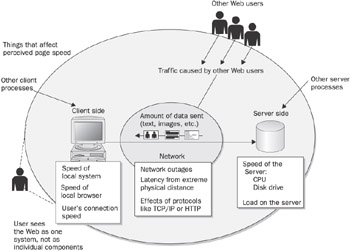Chapter 16: HTTP and Site Delivery
| < Day Day Up > |
As you develop your Web pages, it's important to consider how to deliver them to the user. Even if developers master the creation of Web pages using HTML/XHTML, CSS, JavaScript and so on, they can still fall flat on their faces if they don't pay careful attention to how they deliver the pages to the user . As far as the viewer of a page is concerned , the Web is one big system. If a page is slow because of a server, the user still views the site in a negative light no matter how correctly implemented the markup or other technology used might be, and in spite of how compelling the content or inspiring the design. Leaving important site delivery considerations until the very end of Web projects is a surefire way to improve the chances the site will fail.
The Importance of Delivery
Unfortunately, delivery issues often are only contemplated after a Web site has been designed and built. In many cases, the budget for the site doesn't significantly consider delivery costs, so corners are cut. This is like spending big money to design and print a corporate brochure, only to have it delivered by third-class postal mail because no funds were left after design and printing. The effect of the brochure would be severely diminished by its slow arrival. Delivery of Web sites is even more critical, particularly given the rise of task-oriented Web sites or e-commerce sites, in which any delay can mean the difference between a successful sale and a lost one.
Although designers might admit that users don't like slow sites, they tend to focus only on a few aspects of what makes a site slow. Consider that users will not be able to distinguish which aspect of site delivery is causing a page to load slowly. They are going to view it as a slow site, whether or not the graphics were optimized properly. Too much emphasis on optimizing file size , and not enough attention to servers, network choice, and even the characteristics of the medium itself, is a common mistake made by Web site designers. Consider all the possible reasons a site might be slow, as illustrated in Figure 16-1.

Figure 16-1: User does not see components affecting Web site delivery speed
Although there are numerous potential problems to consider when delivering a site, the one inescapable fact is that, eventually, data will have to be transferred. Whether you download now or download later, you eventually have to do it. From the user's perspective, how much data is downloaded doesn't really matter; it only matters how responsive the site is. The user only counts the seconds on his or her watch, not the number of bytes delivered. How much data comes down doesn't matter to the end user. Furthermore, if you are using huge graphics by downloading them during the idle moments, the user certainly won't care.
The bottom line is keeping the user happy. If your design requires a great deal of bandwidth, has many individual requests , or requires real-time delivery, you might have to shelve it. Always respect the medium of the Web. Just as a print designer understands that ink might bleed through paper, Web designers should understand the nature of the network and servers used to deliver their creations.
| < Day Day Up > |
EAN: 2147483647
Pages: 252